Rocksteady Losing the Passion for Batman in Knight's Open World Activities
By project343 13 Comments
(THIS POST CONTAINS SPOILERS FOR ARKHAM KNIGHT AND ARKHAM ASYLUM.)
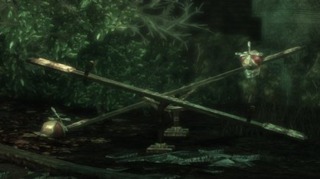
The one thing that Arkham Asylum holds over its successors is a contagious admiration and respect for the property that its based on. Every inch of that game oozes fandom and passion: from the wealth of villains who cameo their way into the main narrative thread, to the core narrative conceit, to the nuggets of tertiary Batman characters who still get their mentionings in the deepest, darkest corners of the asylum. From hidden gems like an ol’ timey radio belonging to Jack Ryder to a pair of see-saws with children’s caps homaging to Tweedle-Dee and Tweedle-Dum: Arkham Asylum is practically indulgent in its love, and it tries its darnedest to pull players into that indulgence. Part of this is thanks to the games setting, part of it is due to the scale, and part of it is simply a product of game design.
When you compare this enthusiasm to the optional content in the most recent release, Arkham Knight deviates in a way that would be incredibly disheartening to the 2009 Rocksteady. Where is the problem? Well, it certainly isn’t with the game’s audiovisual components. They are probably even more indulgent than its predecessor (just look at the game’s masterful, almost pornographic camera work). It’s all in the design, its accompanying UI, and its self-imposed narrative limitations.
The Ubiverse & Open World Activities
I can’t speak to the goings-on at Rocksteady during development, but I’d wager that the design team and their higher-ups were laser-focused on packing the game full of a variety of generic open world activities. This push feels like a response to severe time constraint, solved by mimicking how other successful open world games have tackled open world content. Significantly more than any other Arkham title, Arkham Knight feels like it belongs in the Ubiverse catalogue: glueing together a collection of fragmented pieces in an incoherent and padded whole. The design team clearly had the reigns, and every other department had to be as agile and lean as possible to react to a game in constant flux. It’s a development studio completely out of sync with itself.
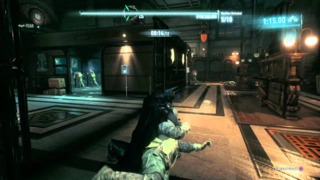
Let us take a look at any random activity. The heists, I guess. The design team wants to pump the game full of optional stealth-oriented activities. Bank heists make sense: it’s a quintessential villainous activity in most comic book worlds, and it opens up opportunities for cool new stealth spaces. For the most part, I think that these activities work from a gameplay perspective. They let the player toy around with the stealth mechanics in a somewhat more chaotic setting. The real problem here is that Rocksteady clearly went into these side activities with the notion that the Arkham series is only made better with a greater cast of villains. So, they point to a seemingly-random villain in their catalogue and assign them to this activity. In this case, it’s Two-Face.
First off, there is virtually nothing iconic about Two-Face relating to banks. If you want to tackle Two-Face, you play to what makes him special: his twisted sense of justice as it relates to chance, or you could play more directly to his history with Bruce and the legal system. In this case, he’s exclusively being positioned as an opportunistic gang leader. The next major issue with this approach is that so many of these villains are used as crescendo, final-act wrap-up to this particular chain of activities. What does this mean for Two-Face? You have a slightly more difficult heist encounter, in another forgettable bank environment, that just so happens to be populated with a named character who operates like any other thug. You dispatch him like a generic thug (I mean, just look at how underwhelming this takedown is), mission is over, and you tie the bow on this activity chain by driving him back to the GCPD. The constraints of highly orchestrated game design start to show here: there is virtually nothing that separates this bank heist from the last one, besides the named figure.
To make matters worse, each activity is copy-pasted an arbitrary number of times Rocksteady is happy with the padding (three Firefly chases, four Penguin stalk-and-punches, etc.). In the case of Dent, there are three bank heists in the game. You dispatch his crew two times, then Dent arrives on the scene by the third robbery and Rocksteady does very little to differentiate this encounter from the previous two. By sticking to the encounter formula established, and feeling the compulsion to pad the world with as much content as possible, Rocksteady transforms what could be a unique and dedicated villain experience into something that the player has seen many times over.
Rinse and repeat this across every other formulaic activity for every supporting villain (who, again, is only tangentially-related to the content that they’re attached to), and you can start to see where Arkham Knight is failing to make good on its world and cast. Rocksteady, over the course of the game’s side content, consistently turns what should be iconic and memorable villain encounters into filling out a quotas.
The UI: Checking Boxes
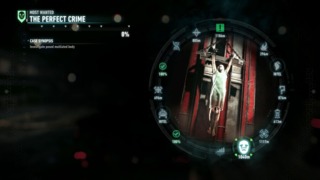
The “quota” feeling is exactly what is wrong with the game’s UI. The game has a clean, straightforward mission UI that conveys so much information in such a tried-and-true radial menu. So what’s the problem? Every side mission has a dedicated space on the radial menu, and the interface is dead set on keeping players informed on their completion percentages. So, as you spin your analogue stick around the mission wheel, you see that you are 30% done with Two-Face, 60% done with Firefly, 35% done with the Riddler, etc..
I’m not entirely sure why these individual percentages exist in the game. The game has a generic game completion percentage that is spotlighted on the main menu, but that is commonplace nowadays: it feeds completionists with a desire to see and do everything in the world. The individual percentage bars are what is baffling. It reminds me a bit of the booming popularity of RPG mechanics in shooters last generation (as brought on by Call of Duty: Modern Warfare). It gives the impression that, like Call of Duty, Rocksteady does not have a ton of confidence in the core mechanics of the game being able to hold the player through to the end. After all, you know what’s more satisfying than filling up a single progression bar? Filling up like ten or fifteen of them!
The other possible explanation for this bizarre inclusion is giving the player a sense of scope and scale. The player, at all times, knows roughly how many more encounters that they’re going to have with Dent’s men, or how many more times they need to tackle Firefly to the ground before he’s finally dealt with. Rather than seeming like an insurmountable breadth of content, the game becomes more realistic and digestible. The question then arises: why bother bloating your game in the first place?
The game also gates most of the open world activities behind frequent main story barriers. You need to finish X-mission before the next batch of Y and Z activities are open. The game’s UI lets you know when no more open world activities are available until you progress the main story some more. It is so kind of the game to let you know that Harvey Dent isn’t going to surprise you for the next little bit. The game wouldn’t want to surprise the player in any meaningful way, right?
For me, this is the crux of the UI issue: it makes the experience fundamentally predictable. I know exactly how many more times Dent is going to strike by looking at his percentage. I know how many more side missions are going to pop up along my adventure by looking at the empty spaces. Hell, I even know that I won’t have to worry about bank robberies in the next little while. Sometimes less is more when it comes to keeping the player informed. At the very least, Rocksteady is consistent. The UI makes the villain encounters more predictable, and the open world activity design makes the villain encounters more predictable.
No Room for Narrative
So what tools do they have left to salvage their optional villain experiences? Well, I guess they have narrative. The narrative conceit of this “Arkham” is roughly the same as all predecessors: its a single evening and Batman is locked in a particular location until he can lock up a variety of iconic villains as they rip the space apart for their own pleasures. So why does it feel so different?
Straight up, the design team has given basically no room for the narrative side of things to make up for rigidity. Each side mission is stuck in its own formula (chase a guy in the batmobile, stealthily take out these bank robbers, etc.), and at no point is the design allowed to break from the previously-established mould with thrilling scripted sequences, or non-combat encounters. Only a select few side missions come with premium cutscenes to heighten the villain encounter; most of the time, it’s just a quick close-up shot of a villain taunting Batman before returning to the core gameplay of that activity. The worst offenders of this are the Firefly and Manbat missions; both have to be taken down several times, and each sequence is almost exactly the same as the previous one--same cutscenes, animations, and all.
About the only medium open available to the narrative is voice over work. And boy, does Arkham Knight relish in that singular method of narrative delivery. Every single villain in the side content is loaded to the brim with taunts, quarreling exchanges, and insults. It’s actually kind of impressive when you think about how many lines of angry, one-direction exchanges that Troy Baker had to record (he had to voice both Two-Face AND the Arkham Knight after all). By the end of the game, the player is so exhausted from hearing generic snarks and taunts over the radio that they have likely turned on a podcast to drown out the game’s optional narrative content.
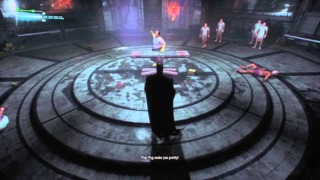
I feel like all it would take is a single memorable, unique environment with some sort of unique encounter with the villains to make these villains truly sing. There is one standout side activity that really leaves its mark on the player, and it has very little to do with the activity itself: Professor Pyg and his “The Perfect Crime” finale. It is a horrifying, memorable boss battle in with unique enemies (the Dollotrons), unique mechanics (Pyg and his Dollotron’s invulnerabilities), and an environment that really pays homage to what makes this villain iconic (his laboratory/captive chamber beneath his beauty parlor). So why does Rocksteady give Pyg an excellent outing sequence when Dent gets a generic-fucking-takedown while robbing a random-ass-bank?
From Asylum to Knight to Asylum
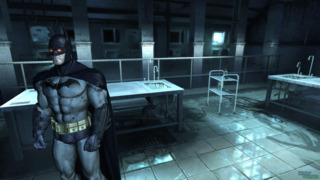
Going back to what I opened with, I just want to bring Arkham Asylum back into this equation. Batman isn’t Batman without his incredible cast of antagonists. In Arkham Asylum, Scarecrow, Poison Ivy, Bane, Joker and Killer Croc are the positioned in the foreground as primary villains. Each has a dedicated space of the asylum that feels distinctly “theirs.” Each villain is given so much time and space to breath and torment our Bruce. For the tertiary villains who do not make it into the game, Rocksteady can’t help but at least acknowledge their existence as beloved characters in this world by filling every corner of the asylum with their memorabilia. More than that, they use riddles to guide the player toward these lovingly crafted homages.
Arkham Asylum is not bloating with generic open world content that feels like is purely in service of the “perceived value” of their retail box. Instead, Arkham Asylum is bloated with an uncontrollable love and affection for its source material. Every villain is given their time and space to shine in the way that feels distinctly them (even if this sometimes leads to gimmicky boss battles). Rather than be berated over the radio by forced VO narrative for every villain imaginable, the player collects patient interview recordings of the game’s cast to better understand their pathologies. That feels so authentically Batman.
In looking at the side mission content in Arkham Knight, I can’t help but get the impression that Rocksteady has lost its passion for the Batman property. As a really big Batman fan, it almost breaks my heart.
(I can’t believe I made it to the end without mentioning Deathstroke. For fuck sake. He’s like the quintessential example of Rocksteady clearly not giving a fuck about these characters. Ugh. Cutting this off now.).
